Public toilet
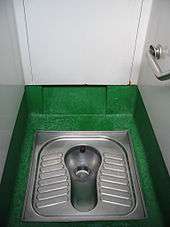
.jpg)
A public toilet is a room or small building containing one or more toilets (and possibly also urinals) which is available for use by the general public, or by customers or employees of certain businesses. Public toilets are commonly separated into male and female facilities, although some can be unisex, particularly the smaller or single-occupancy types. Increasingly, public toilets are accessible to people with disabilities.
Public toilets may be provided by the local authority or by a commercial business. They may be unattended or be staffed by a janitor or attendant (possibly with a separate room). In many cultures, it is customary to tip the attendant; pay toilets charge a small fee for entrance, sometimes by use of a coin-operated turnstile. Some venues such as nightclubs may feature a grooming service provided by an attendant in the room. Portable toilets are often provided at large outdoor events.
Public toilets are typically found in schools, offices, factories, and other places of work; in museums, cinemas, bars, restaurants, and other places of entertainment; in railway stations, filling stations, and on long distance public transport vehicles such as trains and planes.
In many Asian, African and Muslim countries, public toilets are of the squat type, as this is regarded as more hygienic for a shared facility.
Terminology
Public toilets are known by many names in different varieties of English. One of the more formal circumlocutions is "public convenience", as in the Guilford Place public conveniences, an architecturally valuable example.
In American English, the term "restroom" usually denotes a public, commercial, or industrial personal hygiene facility designed for high throughput. However, "bathroom" is now more commonly used. The word "washroom" is used in some parts the United States for a "laundry room" or utility room. (See Wash house, a historic term for a public place to wash clothes, similar in function to a self-service laundry.) Another euphemism is "comfort station", sometimes associated with visitor welcome centers, e.g. in national parks.
In Canadian English, public facilities are always called "washrooms". As men's and ladies' facilities are not normally situated next to each other in department stores, they may be referred to simply as "the ladies' room" or "the men's room". The word "toilet" generally denotes the fixture itself rather than the room. The word "washroom" is never used to mean "utility room" or "mud room". "Bathroom" is generally used to refer to the room in the home.
In Britain, Australia, Hong Kong (as "toilets"), Singapore (as "toilet") and New Zealand, the terms in use are "public toilet", "public lavatory" (abbreviated "lav") and more informally, "public loo". A "bathroom" is a room containing a bath, a "washroom" is a room for washing hands, and a "restroom" is a room to rest in when tired; none of which would necessarily contain a toilet. Public toilets were traditionally signed as "Gentlemen" or "Ladies", and as the Gents or the Ladies; these terms remain in colloquial use.
In the Philippines, "comfort room", or "C.R." for short, is the most common term in use.[1]
In non-English speaking Europe, either the local translation of "toilet" (for example toilettes in French), or "WC" (abbreviation for "water closet", an old-fashioned term for the flush toilet) are common.
Types

Some public toilets are mobile, and can thus be put in place where and when needed, e.g. for a festival. In this sense, a portable toilet is a temporary outdoor enclosure which can either be connected to the local sewage system, or store the waste in a holding tank to be emptied by a vacuum truck. Portable toilets may be cleaned and the tank emptied on location, or they may be moved back to a central base for servicing.
Other temporary designs can be sunk into the ground (and thereby made inoperable), for the periods that they are not needed.[2] The idea behind this is that some people do not like the sight of a public toilet in the street, and they are more easily hidden rather than repeatedly moved. This retractable model is typically installed in entertainment districts and made operational only during weekend evenings and nights. These are mostly for male urination needs, and follow the model of the French pissoir.
In Europe and the US, permanent public toilets are often installed and maintained by private firms, see Privatization of public toilets. The companies are then permitted to use the external surfaces of the enclosures for advertising. The installations are part of a street furniture contract between the out-of-home advertising company and the city government, and allow these public conveniences to be installed and maintained without requiring funds from the municipal budget.
An automatic, self-cleaning toilet called The Sanisette, invented by the French company JCDecaux, was launched in Paris. It works by cleaning and disinfecting the whole room automatically, within 60 seconds after a person has finished using it.[3]
Modern design
Doorless entry
Modern public toilets may be designed with a labyrinth entrance (doorless entry), which prevents the spread of disease that might otherwise occur when coming in contact with a door. Doorless entry provides visual privacy while simultaneously offering a measure of security by allowing the passage of sound. Doorless entry also helps deter vandalism; fewer audible clues to another person entering discourages some vandals. Doorless entry may also be achieved simply by keeping an existing door propped open, closed only when necessary.
Service access
Modern public toilets often have a service entrance, utilities passage, and the like, that run behind all the fixtures. Sensors are installed in a separate room, behind the fixtures. Usually the separate room is just a narrow corridor or passageway.
Sensors
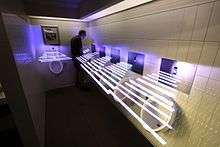
Sensor-operated fixtures (faucets, soap dispensers, hand dryers, paper towel dispensers) prevent the spread of disease by allowing patrons to circumvent the need to touch common surfaces. Sensor-operated toilets also help conserve water by limiting the amount used per flush, and require less routine maintenance. Each sensor views through a small window into each fixture. Sometimes the metal plates that house the sensor windows are bolted on from behind, to prevent tampering. Additionally, all of the electrical equipment is safely behind the walls, so that there is no danger of electric shock. However, a RCCB must be used for all such electrical equipment.
Lighting
Service lighting consisting of windows that run all the way around the outside of the toilet uses electric lights behind the windows, to create the illusion of extensive natural light, even when the toilets are underground or otherwise do not have access to natural light. The windows are sometimes made of glass brick, permanently cemented in place. Lighting installed in service tunnels that run around the outside of the toilets provides optimum safety from electrical shock (keeping the lights outside the toilet), hygiene (no cracks or openings), security (no way for vandals to access the light bulbs), and aesthetics (clean architectural lines that maintain a continuity of whatever aesthetic design is present, e.g., the raw industrial urban aesthetic that works well with glass brick).
Cisterns (tanks)
Older toilets do not often have service ducts and often in old toilets that have been modernized, the toilet cistern might be hidden in a purpose-built 'box' tiled over. Often old toilets might still have high-level cisterns in the service ducts. On the outside, the toilet will be flushed by a handle (just like an ordinary low-level cistern toilet) although behind the wall this handle will activate a chain. Sometimes a long flushing trough will be used to ensure that the cistern can be refilled quickly after dual flushes. This trend of hiding cisterns and fittings behind the walls started in the late 1930s in the United States and in the United Kingdom from the 1950s and by the late 1960s it was unusual for toilet cisterns to be visible in public toilets. In some buildings such as schools, however, a cistern can still be visible, although high-level cisterns had become old-fashioned by the 1970s and a lot of schools now have low-level cisterns.
Fixtures
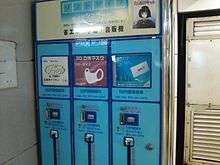

Public toilets generally contain several of the following fixtures:
- Air fresheners or odour control systems
- Antiseptic handwash dispensers or soap dispensers - pump bottle or auto dispenser
- Bidets (not universal; most common in Western and Central Europe)
- Garbage can (rubbish bin)
- Hand dryer - manual or with auto sensors
- Handwash faucets (taps), some at a lower level for children and wheelchair users
- Infant changing tables, often fold-down (usually in women's rooms, but increasinly in men/s rooms, due to legal changes[4])
- Mirrors, usually over sinks
- Paper towel dispenser - often when hand dryers are not installed; sometimes with auto-sensors for touchless dispensing
- Sometimes showers are also present, often with soap, shampoo, or similar dispensers (often at truck stops)
- Toilets, located within stalls with locking doors
- Urinals (almost exclusively in men's rooms; see female urinal)
- Vending machines dispensing condoms, diapers (nappies), painkillers, energy drinks, perfume, breath mints, facial tissue, confectionery, undergarments, swimwear, soap, sex toys, or sanitary napkins or tampons
- Coat hook, usually within the individual stall
- "Pull-down" purse holder, within the individual stall
Public toilets by their nature have heavy usage, so they may rely on a flushometer with a stronger and louder flush than a home-usage toilet. Some high-vandalism settings, such as beaches or stadiums, will utilize metal toilets.
Some public toilets have begun to be provided with flushable paper covers for the toilet seat, which allow the user the comfort of knowing that they are not in contact with a surface previously used by a stranger. However, there is no scientific evidence that these prevent the spread of disease.[5]
Society and culture
Graffiti
Public toilets have long been associated with graffiti, often of a transgressive, gossippy, or low-brow humorous nature (cf. toilet humour). The word latrinalia—from latrine (toilet) and -alia (a collection)—was coined to describe this kind of graffiti.[6] A famous example of such artwork was featured on the album cover of the satirical Tony Award Broadway musical Urinetown, using felt-tip pen scribblings.
Street art

As graffiti merged into street art, so some public street-level toilets began to make a feature of their visibility. The Hundertwasser toilet block is a colourful example in Kawakawa, New Zealand, designed by an Austrian artist and viewed as a tourist draw in a small town.
Racial segregation
In parts of the United States, public toilets were subject to racial segregation, due to the Jim Crow laws prior to the Civil Rights Act of 1964. This imposed significant restrictions on the lives of African-Americans.[7] Those who were able to afford cars could avoid the indignities of segregated trains and buses, but they faced the difficulty of finding a public toilet they were allowed to use. Courtland Milloy of the Washington Post recalled that on cross-country roadtrips in the 1950s his parents were reluctant to stop the car to allow the children to relive themselves - it just wasn't safe.[8] One solution to this was to carry a portable toilet (a sort of bucket-like arrangement) in the trunk of the car.[9] This treatment led to the creation of The Negro Motorist Green Book, an annually updated guidebook. Coping with discrimination on the road took some planning:
Uncle Otis had made this trip before, and he knew which places along the way offered "colored" bathrooms and which were better just to pass on by. Our map was marked and our route was planned that way, by the distances between service stations where it would be safe for us to stop.[10]
Once the traveler had found the correct "colored restroom", however, it could serve "as a respite from the insults of the white world",[11] akin to what is now called safe space.
Transgender issues
In the 21st century, with increased exposure of the transgender community, there have been some initiatives calling for gender-neutral public toilets, instead of only male and female ones, to accommodate genderqueer individuals.[12] Political activists have drawn on the commonality between public toilets being segregated formerly by race and still by sex.[13][14] This has become an increasingly contentious issue, as shown in the battles over North Carolina's Public Facilities Privacy & Security Act 2016.
Legislation
Employees' rights to use the toilet vary between jurisdictions.
The Restroom Access Act is legislation passed by several U.S. states that requires retail establishments that have toilet facilities for their employees to also allow customers to use the facilities if the customer suffers from an inflammatory bowel disease or other medical condition requiring immediate access to a toilet.
United Kingdom
In the United Kingdom, the Workplace (Health, Safety and Welfare) Regulations 1992 requires businesses to provide toilets for their employees,[15] along with washing facilities including soap or other suitable means of cleaning. Guidance on how many toilets to provide and what sort of washing facilities should be provided alongside them is given in the Workplace (Health, Safety and Welfare) Approved Code of Practice and Guidance L24, available from Health and Safety Executive Books.[16]
But there is no legal obligation on local authorities to provide public toilets, and although in 2008 the House of Commons Communities and Local Government Committee called for a duty on local authorities to develop a public toilet strategy,[17] this was rejected by the Government.[18]
As a result of the Sexual Offences Act 2003, sexual acts in a public toilet (cottaging) are illegal.[19][20][21]
Gender issues
Public toilets may be segregated by biological sex as indicated by written signs or pictograms, or alternatively may be used without this distinction.
Separation by sex
In many cultures, separation by sex or gender is so characteristic of public toilets that pictograms of a man or a woman are used to indicate locations of the respective toilets, often without explicit reference to the fixtures themselves. In restaurants and other private locations, the identifications can be designed to match the decoration of the premises.[22] Some toilets also function, in part, as changing rooms (locker rooms), owing to their gender-segregated nature. For example, in beach areas, a portion of the building is equipped with benches so that people can change into or out of their bathing suits.
In jurisdictions using the Uniform Plumbing Code, sex separation is a legal mandate via the building code.[23]Amnesty International includes segregated toilets among its list of suggested measures to ensure the safety of females in schools.[24] In many places the queues for the women's toilets are longer than those for the men's; efforts to deal with this are known as potty parity. Pay toilets disproportionately affect women.[25]
Difficulties with segregation
Gender-segregated public toilets are a source of difficulty for some people; for example, men caring for babies may find that only the women's toilet has been fitted with a baby changing facility. Single men (such as divorced fathers) have similar problems when exercising visiting rights to their young daughters if they have only public areas to resort to. Legislation has been proposed in California that "requires buildings owned or partially owned by state or local governments, as well as other private buildings open to the public, as specified, to maintain at least one safe, sanitary, and convenient baby diaper changing station that is accessible to women and men".[4][26][27][28] People with disabilities who need assistance to use the restroom have an additional problem if their helper is a different gender to themselves. Transgender and gender non-conforming persons also may be subject to embarrassment, harassment, or even assault or arrest by others offended by the presence of a person they interpret as being of a different anatomical sex to themselves.[29]
Gender neutrality
Many public toilets have either individual or gender-neutral facilities. These can accommodate people with disabilities, elderly persons who may require assistance from a carer of another gender, or other cases where public gender-segregated facilities might lead to discomfort.[30] There are also gender-neutral toilets in cases where gender-segregated ones are not practical, such as in aircraft lavatories and passenger train toilets. Toilet facilities for disabled people, especially those reliant on a wheelchair, may be either unisex or gender-specific.[31]
In Unicode
Unicode provides several symbols for public toilets.[32]
| Symbol | Code | Name | Value | Image |
|---|---|---|---|---|
| 🚹 | U+1F6B9 | MENS SYMBOL | men's restroom | |
| 🚺 | U+1F6BA | WOMENS SYMBOL | women's restroom | |
| 🚻 | U+1F6BB | RESTROOM | restrooms or unisex restroom | |
| 🚼 | U+1F6BC | BABY SYMBOL | baby changing station | |
| ♿ | U+267F | WHEELCHAIR SYMBOL | disabled accessible facilities | |
| 🚽 | U+1F6BD | TOILET | restroom | |
| 🅏 | U+1F14F | SQUARED WC | restroom with flush toilet | |
| 🚾 | U+1F6BE | WATER CLOSET | restroom with flush toilet | |
| 🚿 | U+1F6BF | SHOWER | shower facilities | |
| 🛀 | U+1F6C0 | BATH | bathing facilities | |
| 🛁 | U+1F6C1 | BATHTUB | bath facilities | |
| Source: [32][33] | ||||
History
Public toilets were part of the Sanitation system of ancient Rome, often in the proximity or as part of public baths (thermae).[34] By the Middle Ages public toilets became uncommon, with only few attested in Frankfurt in 1348, in London in 1383, and in Basel in 1455.[35]
One term now fallen into disuse is "longhouse", from Whittington's Longhouse, set up in fifteenth century London.[36]
In the early 19th century, large cities in Europe started installing public toilets: first in Paris, then in Berlin in 1820 and in London in 1851.[35]
George Jennings, the sanitary engineer, introduced public toilets, which he called "monkey closets", to the Crystal Palace for The Great Exhibition of 1851.[37] He also used the euphemism "halting station",[38] now in use in Indian English for a basic place to stay attached to a railway station. Public toilets were also known as "retiring rooms"[39] (cf "Drawing room", from "to withdraw", and Waiting room.)
Underground public toilets were introduced in the United Kingdom in the Victorian era, in built-up urban areas where there was no space to provide them above ground. The facilities could be accessed by stairs, and were lit by glass brick on the pavement. Underground public toilets were often built to a high standard by local health boards, although there was a much higher provision for men than women. Most have been closed as they did not have disabled access, and were more prone to vandalism and sex abuse, especially if there was no attendant. A few remain in London, but others have been converted into alternative uses such as cafes, bars and even dwellings.
Facilities for women sometimes had a wider emphasis, providing a safe and comfortable private space in the public sphere. The Ladies Rest Room is one example of the non-euphemistic use of the term.
A notable early example of a public toilet in the United States is the Old School Privy. The American architect Frank Lloyd Wright claimed to have "invented the hung wall for the w.c. (easier to clean under)" when he designed the Larkin Administration Building in Buffalo, New York in 1904.
Gallery
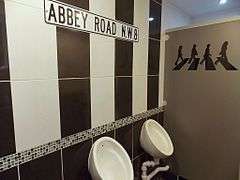
- Typical North American public restroom
.jpg) Public toilet at the Vienna State Opera has recorded music
Public toilet at the Vienna State Opera has recorded music 19th-century gents' washroom at University of Oslo
19th-century gents' washroom at University of Oslo Roadside squat toilet near Toulouse, France
Roadside squat toilet near Toulouse, France Movable handicap-access toilet in Luxembourg
Movable handicap-access toilet in Luxembourg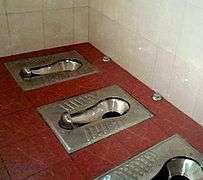 Squat toilets in Beijing, China
Squat toilets in Beijing, China Old-style public toilet in a Hong Kong factory
Old-style public toilet in a Hong Kong factory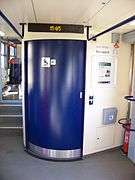 Public toilet aboard a train in the Czech Republic
Public toilet aboard a train in the Czech Republic.jpg) Coach class public toilet for Czech train
Coach class public toilet for Czech train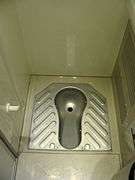 Squat toilet in a high-speed train on the Guangshen Line in China
Squat toilet in a high-speed train on the Guangshen Line in China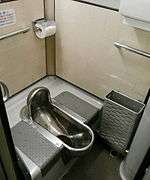 Squat toilet aboard a Japanese Ginga train
Squat toilet aboard a Japanese Ginga train.jpg) Roadside public toilet in Japan
Roadside public toilet in Japan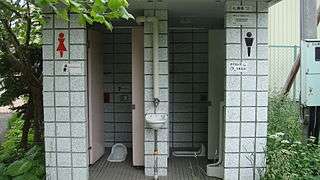 Public toilet at Jozankei Hot Springs, Hokkaido, Japan
Public toilet at Jozankei Hot Springs, Hokkaido, Japan.jpg) Entrance to an underground public toilet in Japan
Entrance to an underground public toilet in Japan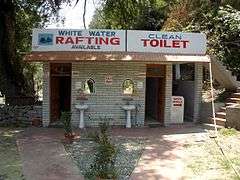 Public toilets near Kullu, India
Public toilets near Kullu, India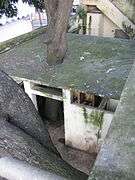 Public toilet near cinema in Bangalore, India
Public toilet near cinema in Bangalore, India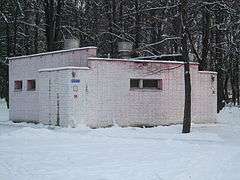 Public toilet in Kuskovo, near Moscow, Russia
Public toilet in Kuskovo, near Moscow, Russia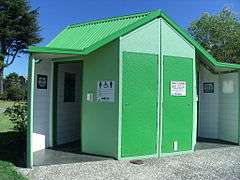 Public toilet in Pukekohe, New Zealand
Public toilet in Pukekohe, New Zealand Historic landmark public toilets in Wellington, New Zealand
Historic landmark public toilets in Wellington, New Zealand
See also
| Wikimedia Commons has media related to Toilet buildings. |
- Latrine
- National Public Toilet Map (in Australia)
- Spray-and-vac cleaning, a method of professional cleaning
References
- ↑ http://globalnation.inquirer.net/cebudailynews/news/view/20100605-273947/Health-official-1-CR-for-every-classroom
- ↑ "Street toilets go telescopic". news.bbc.co.uk. Retrieved 20 January 2014.
- ↑ Mulrooney, Thomas. "Public Toilets Around the World". Plumbworld News. Archived from the original on 1 November 2013. Retrieved 20 January 2014.
- 1 2 "Should men's restrooms have diaper changing tables? New bill says yes". Retrieved 6 July 2014.
- ↑ MIT medical: Ask Lucy archive on paper toilet seat covers. June 28, 2006
- ↑ Palazzolo, Rose. "Latrinalia - Learning From the Scrawls in the Bathroom". ABC News. Retrieved 30 October 2013.
- ↑ Published in The Public Historian, ed. Randolph Bergstrom, Volume 27, Issue 4, Fall 2005, pages 11-44. Weyeneth, R. R. (2005). The architecture of racial segregation: The challenges of preserving the problematic past. The Public Historian, 27(4), 11-44. DOI: 10.1525/tph.2005.27.4.11
- ↑ Milloy, Courtland (June 21, 1987). "Black Highways: Thirty Years Ago We Didn't Dare Stop". The Washington Post. Retrieved October 24, 2016.
- ↑ Sugrue, Thomas J. "Driving While Black: The Car and Race Relations in Modern America". Automobile in American Life and Society. University of Michigan. Retrieved October 24, 2016.
- ↑ Wright, Gavin (2013). Sharing the Prize. Harvard University Press. pp. 75–76. ISBN 9780674076440.
- ↑ Molotch, ed. by Harvey; Norén, Laura (2010). Toilet. ; Public Restrooms and the Politics of Sharing. New York: New York University Press. ISBN 0814795897.
- ↑ Toilet: Public Restrooms and the Politics of Sharing - Page 192, Laura Noren - 2010
- ↑ La Ganga, Maria L (30 March 2016). "From Jim Crow to transgender ban: the bathroom as battleground for civil rights". The Guardian. Retrieved 24 October 2016.
- ↑ Milhiser, Ian (6 Nov 2015). "How The Religious Right Learned To Use Bathrooms As A Weapon Against Justice". Think Progress. Retrieved 24 October 2016.
- ↑ Workplace (Health, Safety and Welfare) Regulations 1992
- ↑ Health and Safety Executive Books
- ↑ "The Provision Of Public Toilets" (PDF). House of Commons. Retrieved 20 January 2014.
- ↑ "Government Response to Public Toilet Provision" (PDF). www.gov.uk. Retrieved 20 January 2014.
- ↑ Galop.org.uk, Cottaging and cruising: your safety, your rights and the law.
- ↑ Kingston Hospital NHS Trust, Sex and the law.
- ↑ Sexual Offences Act 2003, part 1, paragraph 71,
- ↑ Michael, Jane; Michael Stern (1999-09-13). "Operators shouldn't get potty over bathroom symbols". Nation's Restaurant News. Retrieved 2009-02-27.
- ↑ 2009 UNIFORM PLUMBING CODE, 412.3 (PDF). Ontario, California: International Association of Plumbing and Mechanical Officials. 2009. p. 34. ISSN 0733-2335.
- ↑ "Six steps to stop violence against schoolgirls, Document ACT 77/008/2007". Amnesty International. November 2007. Retrieved 2009-02-27.
- ↑ Maschke, Karen (1997). Feminist legal theories. p. 131. ISBN 9781138861404.
- ↑ Senate Floor Analyses http://leginfo.legislature.ca.gov/faces/billAnalysisClient.xhtml?bill_id=201320140SB1358#
- ↑ Jerry Brown vetoes bills to help men change baby diapers Sacramento Bee. SEPTEMBER 19, 2014 http://www.sacbee.com/news/politics-government/capitol-alert/article2610428.html
- ↑ SB-1358 Baby diaper changing stations http://leginfo.legislature.ca.gov/faces/billNavClient.xhtml?bill_id=201320140SB1358
- ↑ Rosen, Jill (2011-04-24). "Victim of McDonald's beating speaks out". The Baltimore Sun. Retrieved 2012-08-18.
- ↑ Devine, Shannon (2004-03-11). "Inclusive toilets". McGill Reporter. Retrieved 2009-02-27.
- ↑ Toilet Signs at Adept Safety Online (informative commercial site)
- 1 2 Unicode.org, Transport and Map Symbols (accessed 6 November 2012)
- ↑ Unicode.org, Miscellaneous Symbols (accessed 6 November 2012)
- ↑ Heikki S. Vuorinen (2010): "Water, toilets and public health in the Roman era", in Water Science & Technology: Water Supply, pg.211
- 1 2 Peter Kasza:"Das große Latrinum: 155 Jahre öffentliche Toilette", in Der Spiegel, 22 June 2007
- ↑ .P. E. Jones Whittington's Longhouse, London Topographical Record, Volume 23, 1972. Pages 27–34
- ↑ Hibbert, Christopher (2008). The London Encyclopaedia. p. 668.
- ↑ Andrews, Margaret. "Sanitary Conveniences and the Retreat of the Frontier: Vancouver, 1886-1926". British Columbian Quarterly (87). Retrieved 25 October 2016.
- ↑ Oxford Dictionary https://en.oxforddictionaries.com/definition/retiring_room. Retrieved 24 October 2016. Missing or empty
|title=(help)
External links
- British Toilet Association Campaigning for Better Public Toilets for All
- Imagining the Socialist Bathroom
- American Restroom Association America's advocate for the availability of clean, safe, well designed public restrooms
- Australia's National Public Toilet Map shows the location of more than 14,000 public and private public toilet facilities across Australia.
- Public Toilets Database Locations of public toilets in 18 countries. New locations and comments can be added. Detailed information includes the geographic coordinates and quality of the facility.
- Needaloo The Uk Online Disabled Loo Locator
- Safe to Pee: A Gender Neutral Restroom Directory
- Find A John: Filterable Restroom Directory
- Finding Best Toilet For Home Use



